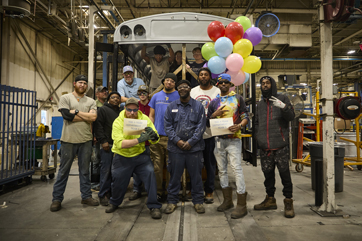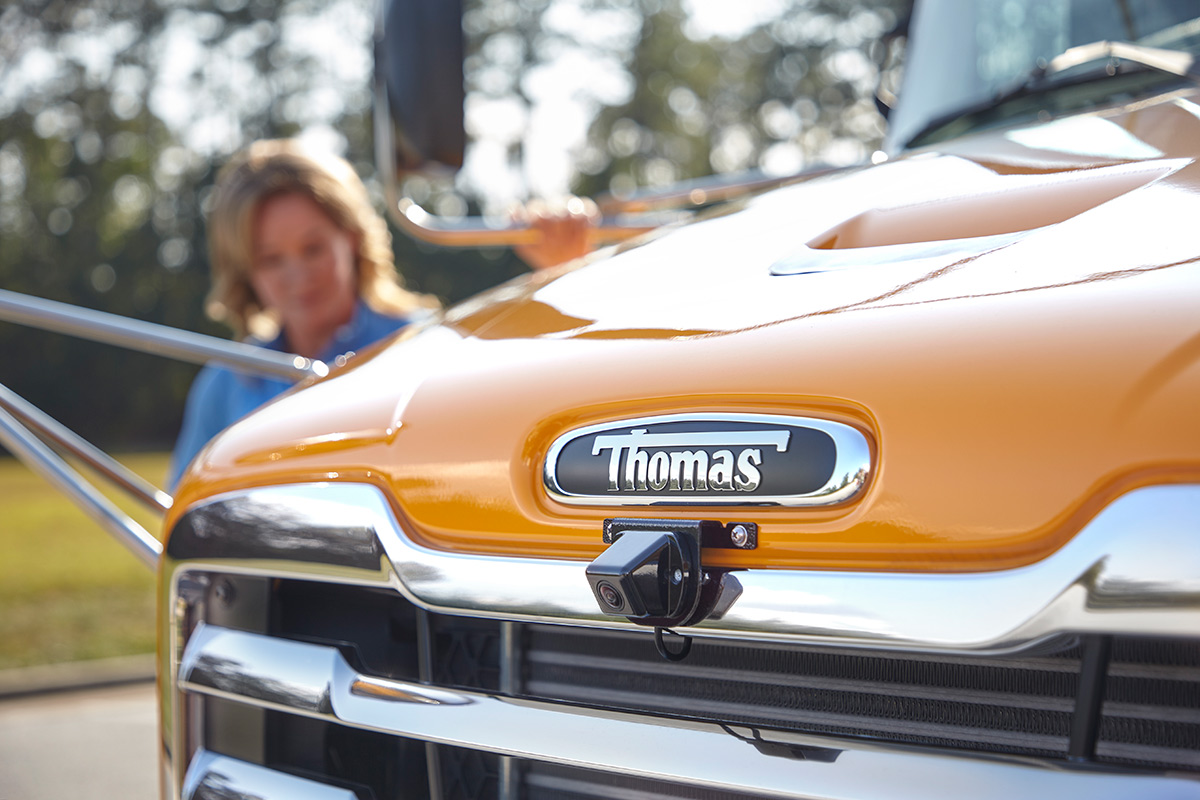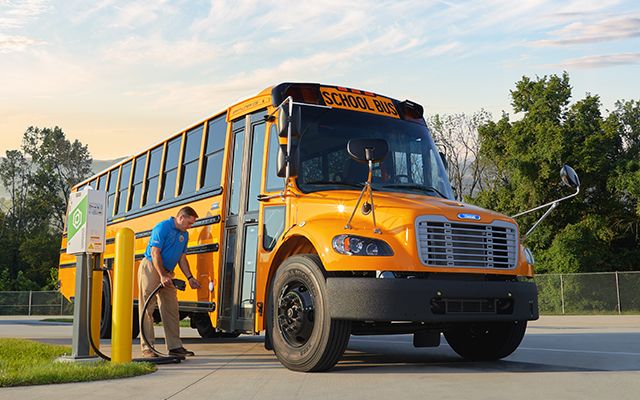
A behind-the-scenes look at our historic celebration and transition of the Type D legacy
It isn’t every day you get to celebrate a major milestone, so we’ve captured the iconic plant transition of our Type D production and commemorated the milestone in a video celebration. Chronicling the final steps of the last Type D bus to roll off the historic assembly line, the video features…

At Thomas Built Buses, we view safety as a journey, not a destination. Safety is at the core of everything we do—from our manufacturing processes to our testing protocols and focus on continuous innovation. It is more than just a feature; it’s an interconnected facet of all our operations.
Let’s look at how this commitment to safety is woven into every phase of our process, from…

What makes the electric Saf-T-Liner C2 Jouley school bus an excellent vehicle for today and the future? Our free Electric School Bus Curriculum answers this and more.
Today’s students are increasingly interested in electric vehicles and environmentally smart transportation options. This dynamic, professionally designed curriculum provides teachers with tools and lessons to increase…

In today’s rapidly evolving industrial landscape, sustainability has become a global focus. But what does that even mean? For Thomas Built Buses, it’s about defining our commitment to our organization, our industry and the communities we serve. While our electric school bus, the Saf-T-Liner® C2 Jouley®, and its many milestones (including the recent delivery of our 1,000th) often come to…

With any school bus purchase, charging/fueling infrastructure is a major consideration. But with the recent popularity of electric school bus options, some fleet managers admit that the ins and outs of charging infrastructure can feel overwhelming.
“Initially you would think that charging infrastructure for an electric school bus is simple and straightforward,” said Mark Childers, Powertrain and Technology Sales Manager at Thomas Built Buses. “While fleet managers understand that it’s very different from diesel, gasoline or propane, what many don’t realize is that there are different types of charging infrastructures to consider, along with varying levels of engineering needed to equip a bus yard. The good news is that with the right partner, the process can be rewarding and pay dividends in the long run.”
To help clarify some of the complexity of electric school bus charging, Childers outlines a few things to consider when planning battery choice and charging infrastructure for a new electric vehicle fleet:
Batteries
It’s no surprise that electric school buses cost more upfront than clean-diesel, gasoline, propane or compressed natural gas school buses. But what fleet managers may not know is that the cost of an electric school bus battery accounts for around 40 percent of the total cost of the bus. This becomes important when and if fleets need to replace the battery down the road. While larger or multiple batteries will increase the range of new electric school buses, they also will increase cost and weight of the bus.
Battery life
The life of an electric school bus battery is largely dependent on how the battery is being used, how the bus is driven, charging infrastructure and vehicle-to-grid (V2G) services (providing unused energy from batteries to the utility grid).
Some battery manufacturers estimate that their batteries will last approximately fifteen years. Still other sources claim that using V2G services, which keeps the battery at a medium-stage charge, can extend battery life by as much as sixty percent. This could mean that some batteries might not need to be replaced at all during the total life of a school bus.
Battery range
Most new conventional electric school buses hitting the market today have a range of around 100 miles, depending on terrain, driving behavior, bus weight, etc. More specifically, Thomas Built Buses’ Saf-T-Liner® C2 Jouley® electric bus, powered by Proterra’s® industry-leading electric vehicle battery technology, currently has a range of 138 miles. While this range should be satisfactory for most districts, it can give others range anxiety. But with proper route planning to optimize charging, electric school buses can meet the range requirements. Plus, newer batteries with advanced technologies are currently in development and are expected to provide extended range at a lower cost.
Battery safety
With any new technology, safety is a top concern. Fortunately, Proterra has been developing batteries and electric technologies for purpose-built electric transportation since 2004. To date, vehicles powered by Proterra have traveled more than 13 million miles and counting. On Thomas Built’s Jouley electric school bus, Proterra’s proprietary batteries are designed and installed with safety and reliability in mind. Proterra battery packs are made from heavy-duty, lightweight ballistic-grade materials and are tested to withstand heat, cold, impact, vibration and submersion.
Each battery cell is inspected and tested before going into the battery pack. If, in the rare case of cell failure, the issue will be isolated to a single cell and will not spread to neighboring cells. All battery cells are constantly monitored via sensors to ensure optimal performance and safe operation, plus liquid cooling in the battery pack keeps all cells at a constant temperature – maximizing battery life and charging capabilities in all climates.
Charging infrastructure
Larger electric fleets may need to have their lot or bus yard retrofitted with many chargers. And smaller fleets may only require a couple of chargers. The decision on how many and what type of chargers are needed comes down to fleet size and usage.
AC vs. DC power charging time
Technically speaking, electric school buses are charged via electric vehicle supply equipment (EVSE), which charges school buses using either alternate current level 2 (AC) or direct current (DC) systems. Generally, AC level 2 systems are less expensive than DC systems, but AC level 2 systems charge electric school buses more slowly. Conversely, DC charging systems charge electric buses more quickly but do cost more upfront.
Standard SAE J1772 J plugs can be used for both AC level 2 and DC fast charging.
- AC level 2: Uses a 208/240V AC power connection to an electrical outlet capable of supplying 30 – 80 amps of current with 19.2 kW max. Most electric school buses today can be partially charged in four to six hours and fully charged in eight hours via AC power. For additional charging power, some electric school bus manufacturers fit their buses with two AC level 2 connections or AC level 2 bidirectional chargers to decrease charging times.
- DC fast charging: Delivers high power directly into an electric vehicle battery system by converting AC power into direct current (DC) using an inverter built into the EVSE. DC fast chargers use 208 -600V AC for charging rates of up to 90 kW and can charge a school bus in as little as two to three hours. With the Proterra charging system, multiple buses can connect to a single charger which will charge each bus sequentially, so fleets can charge more buses more quickly. Thomas Built Buses is currently the only manufacturer to offer DC charging as standard on their product.
Lot layout
Buses must be plugged into charging infrastructure for several hours, so the layout of a lot and parking options are major considerations. Most charging infrastructure requires access to 3-phase power, so installing the charger close to a building can help to minimize costs.
Consider proximity to buildings as well as parking options around it. With these parameters in mind, some bus yards are not able to accommodate some types of charging infrastructure without utility upgrades to transmission lines, while many new builds or renovated properties can accommodate conduits directly in the ground.
Managed vs. unmanaged charging
Unmanaged charging infrastructure isn’t programmed to avoid charging during peak times, costing districts more. Instead, Childers recommends opting for managed charging infrastructure, which allows fleets to plug in a bus and have the bus only charge when and if needed. The chargers can also be programmed to charge the school bus during the least expensive times of day, thereby decreasing total energy costs.
Utility provider offerings
Finally, it’s important to coordinate with local electric utility providers to discuss charging infrastructure needs. On average, it can take anywhere from 6–12 months to get infrastructure permits, power upgrades, and installation complete, so it’s important to begin planning as early as possible.
“This is a crucial step for many of our customers,” said Childers. “Together with our Thomas Built Buses Electric Bus Authority Team, our customers work with the utility providers to discuss rates, possible energy buy-back or battery storage revenues, infrastructure types, AC vs. DC charging options, power location, and more. These discussions ensure that your bus and charging infrastructure are as compatible and efficient as possible. Plus, as an added bonus, some utility providers offer grants to offset some of the infrastructure costs.”
In addition to helping customers navigate relationships with their local utility provider, Childers says that the Thomas Built Electric Bus Authority team partners with customers through the entire process of securing an electric bus, installing infrastructure, and even offering driver and technician training.
“We really do work alongside our customers from the point when they begin to consider an electric bus until the bus is on the road running routes,” said Childers. “Electric school buses are new for everyone, so we do all that we can to make the process as smooth and as enjoyable as possible.”
In the end, choosing the best school bus and charging infrastructure always comes down to the unique needs of each district. When purchasing an electric school bus or to learn more, work closely with your Thomas Built dealer or speak with someone at the Electric Bus Authority to ensure that your buses and batteries are spec’d perfectly for your needs.
